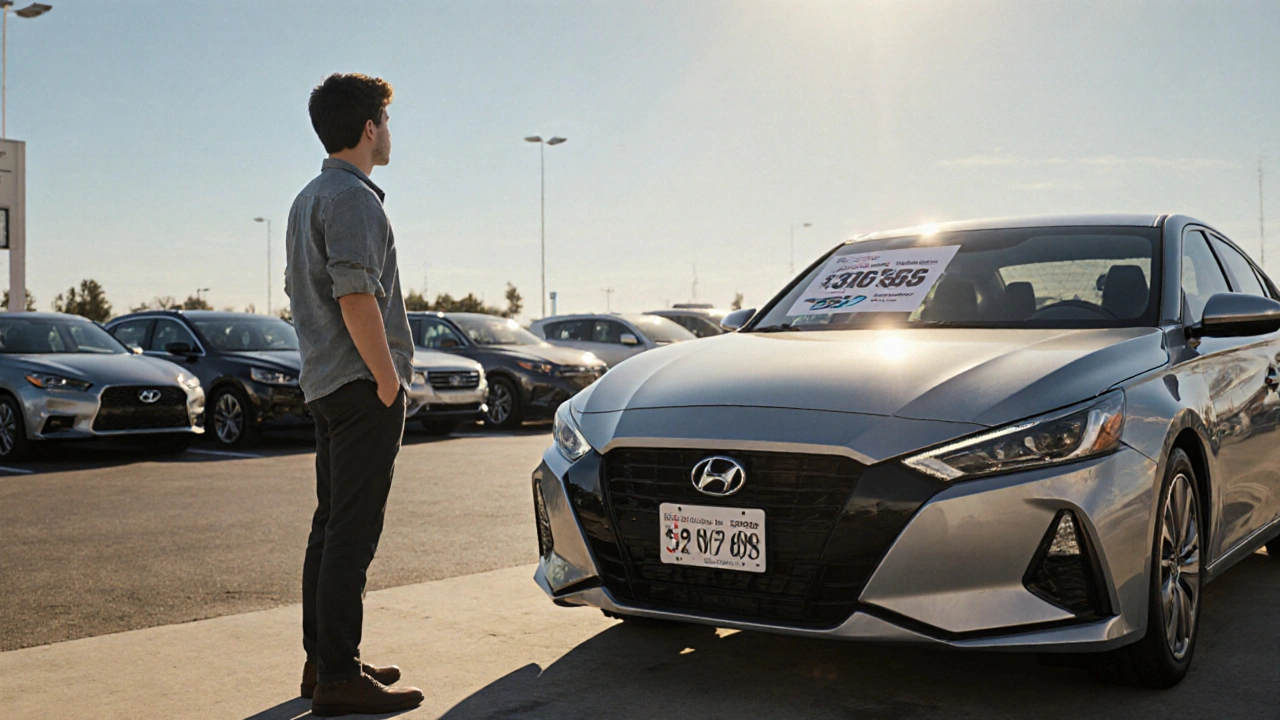Used Car Price Negotiation Calculator
Enter the sticker price of the used vehicle to calculate your potential savings through negotiation.
Estimated Savings
Typical Negotiation Range: 7-10% of sticker price
Average Savings:
Fair Market Price:
Negotiation Tips
Based on your research:
- Start 5-10% below your target price to create negotiation space
- Reference dealer holdback (2-3%) to strengthen your position
- Compare with KBB, NADA, and Edmunds benchmarks for fair pricing
- Separate car price from trade-in and financing to avoid hidden markups
When you walk onto a lot full of Used Car is a pre‑owned vehicle that has already been driven by someone else, the first thing on most people’s minds is the sticker price. That number can feel set in stone, but it’s actually the starting point for a used car negotiation. Knowing where the price comes from, which parts are flexible, and how to talk the dealer’s language can shave thousands off the bill.
Why the Sticker Price Isn’t the Final Word
Dealerships don’t price a vehicle based on what they paid; they layer several cost figures on top of each other. Understanding those layers lets you pinpoint the real room for negotiation.
- MSRP is the Manufacturer’s Suggested Retail Price, a benchmark that often overstates what the market will actually pay.
- Dealer Invoice Price is the amount the dealer reports paying the manufacturer, but it usually hides holdbacks and incentives.
- Holdback is a percentage (typically 2-3%) that the manufacturer refunds to the dealer after sale, effectively lowering the true cost.
- Reconditioning fees cover cleaning, minor repairs, and inspection-costs you can question.
Every one of those numbers can be a lever in the discussion. The trick is to know which ones the dealer can actually move.
How Much Can You Really Negotiate?
There’s no one‑size‑fits‑all answer, but industry data gives a useful range. According to Kelley Blue Book (KBB) data collected in 2024, shoppers who negotiate effectively save an average of 7‑10 % off the sticker price on certified pre‑owned cars. In cash‑rich markets like California or Florida, that discount can stretch to 12 %.
For a $25,000 CPO vehicle, a 9 % reduction equals $2,250. That’s enough to cover a clean Carfax report, a fresh set of tires, or even a modest down payment on an auto loan.
Tools to Benchmark a Fair Price
Before you say a word to a salesperson, arm yourself with three independent valuations:
- KBB provides a “Fair Purchase Price” based on region, mileage, and condition.
- NADA Guides often reflects dealer wholesale prices, giving you a sense of the dealer’s floor.
- Edmunds aggregates real‑world transaction data from thousands of sales.
Print or screenshot these numbers and keep them handy during the discussion. When the dealer’s offer diverges, you have concrete evidence to back your counter‑offer.

Negotiation Tactics That Actually Work
Here are five steps that turn the numbers into a compelling story for the dealer:
- Start Below Your Target. If your research says $22,500 is fair, begin at $20,000. It gives you wiggle room and signals you’re serious about a deal.
- Separate the Car Price from Trade‑In and Financing. Talk about the purchase price first, then discuss your trade‑in value and loan terms. Bundling everything together lets the dealer hide fees in later numbers.
- Reference the Holdback. Mention that you know dealers receive a 2‑3 % holdback, and ask them to account for it in the final price.
- Leverage Certified Pre‑Owned Benefits. CPO programs often include manufacturer‑backed warranties, which cost the dealer extra. Use that as bargaining power to ask for a deeper discount.
- Be Ready to Walk Away. The moment you signal you have other options-another dealer, a private seller, or a later purchase date-the dealer is more likely to meet your price.
These moves aren’t about being aggressive; they’re about showing you understand the math behind the price.
When to Expect Less Flexibility
Not every used car offers the same negotiating bandwidth. Pay attention to these red flags:
- High‑Demand Models: Sports cars or limited‑edition trims often sell at or above MSRP because demand outstrips supply.
- Near‑End‑of‑Month Inventory: Some lots actually hold firm on price to meet monthly sales quotas.
- Dealer‑Specific Promotions: “Zero‑percent financing” or “cash‑back offers” can mask a higher sale price.
If you encounter any of the above, shift your focus to getting extra perks-free maintenance, extended warranties, or a prepaid maintenance plan-rather than a pure price cut.
Financing and the Bottom Line
Even after you lock in a purchase price, the total cost of ownership depends on financing terms. A lower interest rate can offset a slightly higher sticker price.
Use the Auto Loan APR calculator from your bank or credit union to compare offers. If the dealer offers 4.9 % APR and your credit union offers 3.5 %, the interest savings over a 60‑month loan can exceed $1,000.
Remember to ask the dealer for the “out‑the‑door” price, which includes taxes, registration, and any dealer fees. Some dealers add a flat “documentation fee” that can be negotiated down or eliminated.

Quick Takeaways
- Average savings on a well‑negotiated used car = 7‑10 % of the sticker price.
- Know the three price benchmarks: KBB, NADA, and Edmunds.
- Start your offer 5‑10 % below your target to create negotiating space.
- Separate car price, trade‑in, and financing to avoid hidden markups.
- Be prepared to walk away; it’s often the fastest way to get a dealer to improve the deal.
Sample Negotiation Script
Below is a concise dialogue you can adapt on the spot:
Salesperson: "The price on this 2022 CPO Camry is $24,500." You: "I’ve checked KBB, NADA, and Edmunds. The fair market range is $22,000‑$22,800. Considering the dealer holdback, I’m prepared to pay $21,500 today." Salesperson: "That’s low. Let me see what I can do." You: "I also have a trade‑in worth $5,000 according to Carfax. If we can meet at $21,500 for the Camry, I’ll finalize the trade‑in and financing right now." Salesperson: "Okay, let me run the numbers." You: (If they counter higher) "I understand, but the out‑the‑door total would still be above my budget. I have a quote from another dealer at $23,000 all‑in. Can we match that?"
This script keeps the conversation focused on numbers and shows you’ve done your homework.
Checklist Before You Sign
- Verify the Vehicle History Report (Carfax or AutoCheck) for accidents, odometer rollbacks, and title issues.
- Confirm the car’s warranty status-CPO vehicles usually come with a 7‑year/100,000‑mile powertrain warranty.
- Ask for a detailed breakdown of all fees; challenge any “dealer processing” charge that isn’t clearly explained.
- Review the financing agreement line‑by‑line; ensure the APR matches the rate you were pre‑approved for.
- Take a final test drive, checking for unusual noises, alignment issues, and electronic glitches.
Cross‑checking these items protects you from surprise costs after you drive away.
Can I negotiate the price of a certified pre‑owned car?
Yes. While CPO cars often carry a premium for the warranty, the listed price still includes dealer markup, holdbacks, and reconditioning fees that are negotiable. Using market benchmarks like KBB and NADA gives you leverage to request a discount.
What’s the difference between MSRP and dealer invoice?
MSRP is the manufacturer’s suggested retail price, basically a starting point for the dealer’s advertisement. Dealer invoice is the amount the dealer claims to have paid the manufacturer, but it often excludes holdbacks and manufacturer incentives, meaning the true floor price is lower.
How important is a Carfax report in negotiations?
A Carfax (or any vehicle history report) can reveal accidents, title problems, or odometer rollback. If the report shows any negative events, you can request a price reduction proportional to the risk-often 5‑10 % per serious issue.
Should I negotiate the trade‑in value separately?
Absolutely. Dealers sometimes give a high trade‑in value to make the purchase price look better, then inflate the car price. Get an independent appraisal (e.g., Kelley Blue Book trade‑in value) and negotiate that figure on its own.
Is it worth waiting for end‑of‑month sales events?
Often yes. Dealers have monthly quotas, and they may be willing to shave a few thousand dollars off a deal to hit those numbers. However, high‑demand models may still hold firm, so combine timing with strong market data.


Comments
Ashley Kuehnel
Great rundown! Just remember to pull the KBB, NADA and Edmunds numbers onto your phone before you walk in, and don’t be shy about pointing out any reconditioning fees that seem vague.
October 23, 2025 at 02:42
adam smith
One must acknowledge that a disciplined approach to holdback considerations is paramount.
November 6, 2025 at 00:02
Mongezi Mkhwanazi
When dissecting the anatomy of a used‑car price tag, one quickly discovers that the sticker is merely a theatrical prop, designed to lure the unsuspecting buyer into a dance of numbers that the dealer can, with relative ease, manipulate; the MSRP, while ostensibly a manufacturer‑suggested benchmark, often inflates the perceived market value by several thousand dollars, thereby granting the dealer an initial cushion; the dealer invoice, presented as a transparent revelation of cost, conveniently omits holdbacks, factory incentives and undisclosed rebates, all of which effectively lower the dealer’s true acquisition cost; holdbacks themselves, typically ranging from two to three percent of the invoice, represent a silent subsidy that the dealer can recoup after the sale, and clever buyers who invoke this fact can often coax a modest concession from the salesperson; reconditioning fees, ostensibly a charge for cleaning and minor repairs, are notoriously vague and can be negotiated away if the buyer requests a detailed itemization; furthermore, the regional market dynamics, such as supply constraints in high‑demand locales, can compress the negotiation bandwidth, yet even in such scenarios, leveraging third‑party pricing guides provides a credible counter‑offer; the three‑pronged valuation methodology-Kelley Blue Book, NADA Guides, and Edmunds-creates a triangulated fair‑price zone that most dealers are reluctant to ignore, especially when the buyer articulates the data confidently; the practice of separating the vehicle price from trade‑in and financing discussions prevents the dealer from offsetting concessions in one area with inflated costs in another; one should also be prepared to walk away, a tactic that psychologically signals alternative options and often triggers a dealer’s “best‑offer” reflex; in my experience, employing these tactics in a systematic, data‑driven manner can routinely yield savings in the seven to ten percent range, translating to several thousand dollars on a typical twenty‑five‑thousand‑dollar purchase; moreover, a disciplined focus on the out‑the‑door price, inclusive of taxes, registration and any documentation fees, ensures that hidden costs do not erode the negotiated discount; finally, a thorough inspection and a Carfax report can uncover latent issues that further justify a price reduction, completing the negotiation loop with both quantitative and qualitative leverage.
November 21, 2025 at 01:08
Mark Nitka
I appreciate the depth, especially the reminder to keep the trade‑in separate; that’s a game‑changer when the dealer tries to mask fees.
December 1, 2025 at 11:08